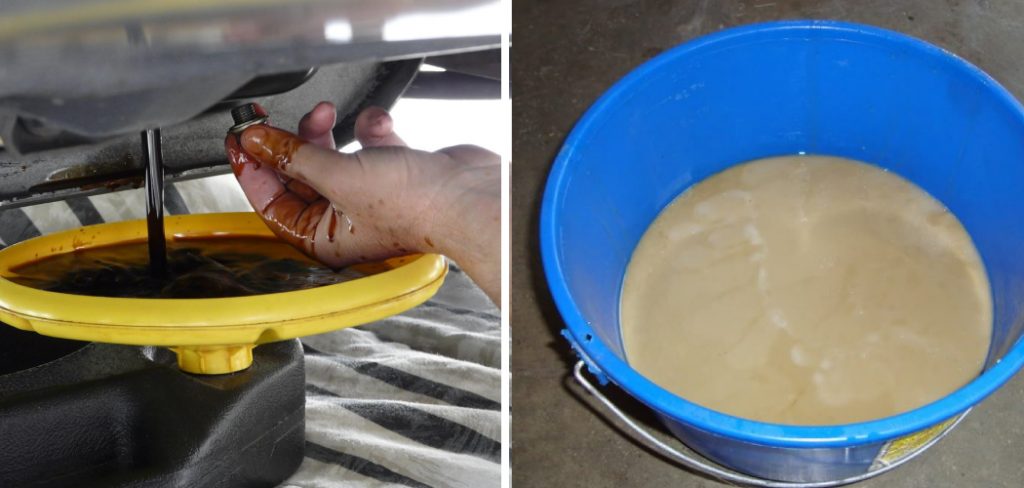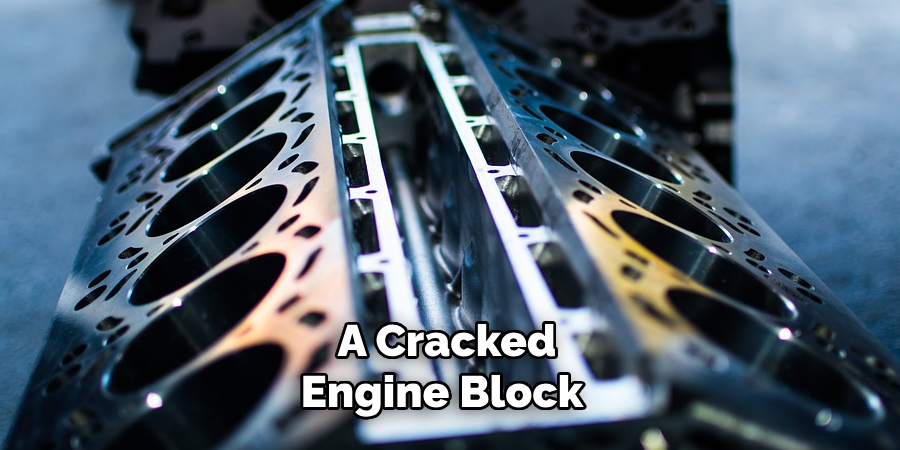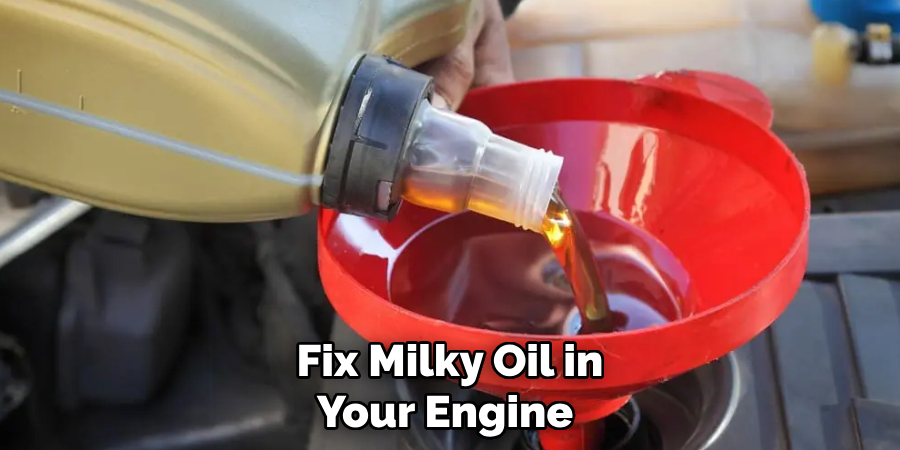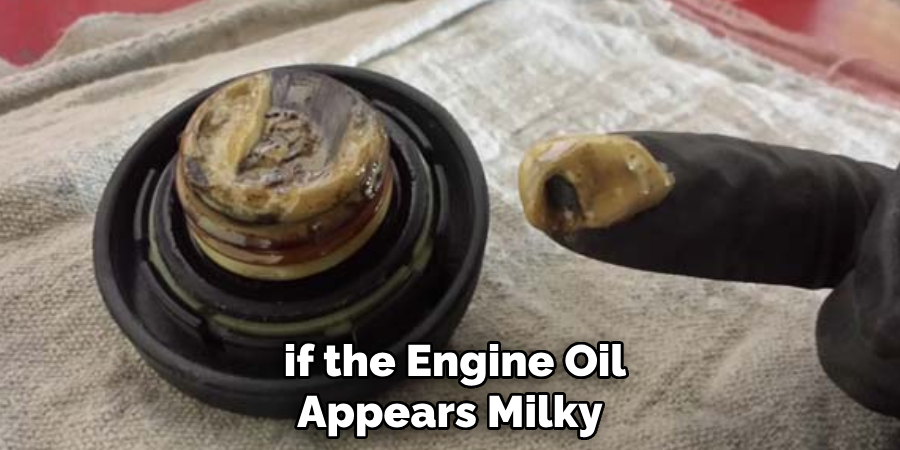Have you ever been mid-drive and noticed the telltale signs of milky oil in your engine? It might feel like an overwhelming problem, but don’t worry – with just a few steps and some basic maintenance knowledge, it’s not too complicated to get yourself back on the road again.

In this blog post, we’ll look at what causes milky oil in engines, how to diagnose it accurately so that you can tackle the root cause rather than symptomatic solutions, and then discuss how to fix milky oil in engine.
In this guide, we’ll explain exactly what causes milky oil formation and how you can go about fixing it yourself without having to call up an expensive mechanic or take your car all the way to the shop. With a few simple tips and tricks, we’ll have you back on the road in no time!
What Causes Milky Oil in Engine?
1 . Improper Oil Mixing
This is the most common cause of milky oil in an engine. It happens when coolant mixes with the engine oil, leading to a white or creamy appearance. This can occur due to faulty gaskets or seals, causing leaks between the coolant and engine oil passages.
2 . Overheating
When an engine overheats, it can cause severe damage to the gaskets and seals. Once these components are damaged, they can no longer seal the engine oil from coolant, resulting in milky oil.
3 . Condensation
In cold weather conditions, condensation can form due to temperature fluctuations inside the engine. This water accumulates over time and mixes with the engine oil, causing it to become milky.
4 . Faulty Head Gasket
The head gasket is responsible for sealing the engine block and cylinder head. If it gets damaged, it can allow coolant to leak into the oil passages, leading to milky oil. Also, a blown head gasket can cause overheating, which further contributes to milky oil.
5 . Cracked Engine Block or Cylinder Head
A cracked engine block or cylinder head can also result in milky oil. This damage can occur due to overheating or engine stress, allowing coolant to mix with the oil.

10 Tips on How to Fix Milky Oil in Engine
1 . Check for Coolant Leaks
One of the most common causes of milky oil in an engine is a coolant leak. Coolant can seep into the engine and mix with the oil, creating a milky appearance. Look for any signs of leaks around your vehicle’s radiator, hoses, water pump, or head gasket. If you notice any leaks, have them repaired immediately to prevent further damage to your engine.
2. Change the Oil and Filter
If you have milky oil in your engine, the first thing you should do is change the oil and filter. This will remove any contaminated oil and prevent further mixing with coolant. Be sure to use a high-quality oil that is recommended for your vehicle’s make and model. Additionally, check the oil filter for any signs of coolant contamination and replace it if necessary.
3. Check the Head Gasket
A blown head gasket can also cause milky oil in an engine. This is due to the mixing of coolant and oil in the combustion chamber. If you suspect a blown head gasket, have it inspected by a mechanic and replaced if necessary. This is a more complex repair, but it will prevent further damage to your engine and ensure that the coolant and oil are not mixing.

4. Use an Oil Additive
There are oil additives available that can help break down any emulsified oil in the engine and eliminate the milky appearance. These additives work by separating the oil from the water, allowing it to be drained out of the engine. However, these additives should only be used as a temporary solution and not as a long-term fix.
5. Flush the Cooling System
If your engine has been contaminated with coolant, it’s important to flush the entire cooling system to remove any traces from the engine. This will prevent further mixing of coolant and oil in the future. A mechanic can perform a thorough flush of the cooling system and ensure that all contaminated fluids are removed.
6. Check for Overheating
Overheating can also lead to milky oil in an engine. When an engine overheats, it can cause coolant to leak into the oil and create a milky appearance. If you have experienced any recent overheating issues, it’s important to have your engine checked and repaired as needed.
7. Replace the Cylinder Head
In some cases, a cracked or warped cylinder head can cause coolant to mix with oil in the engine. This is a more serious issue and will require the replacement of the cylinder head. It’s important to address this problem promptly to prevent further damage to the engine.
8. Fix Transmission Cooler Lines
If your vehicle has an automatic transmission, a leak in the cooler lines can also cause milky oil in the engine. These lines carry transmission fluid to and from the radiator, and if they are damaged or leaking, it can lead to contamination of the oil.
9. Inspect the Oil Pan Gasket
A faulty oil pan gasket can also be the culprit behind milky oil in an engine. If the gasket is damaged or worn out, it can allow coolant to seep into the oil and create a milky appearance. Have a mechanic inspect the gasket and replace it if necessary.
10. Preventative Maintenance
Regular maintenance is key to preventing any issues with milky oil in your engine. Be sure to follow the recommended maintenance schedule for your vehicle, including oil changes and coolant flushes. Additionally, be on the lookout for any signs of leaks or overheating and address them promptly to avoid further damage to your engine.
By following these tips, you can effectively fix milky oil in your engine and prevent it from happening in the future. Remember to always consult with a mechanic if you are unsure of any repairs or if the issue persists. Proper maintenance and prompt repairs will keep your engine running smoothly and extend its lifespan. So, be proactive about taking care of your vehicle’s engine to avoid any potential issues.

Frequently Asked Question
What Precautions Can I Take to Avoid Milky Oil in Engine?
To avoid milky oil in your engine, there are a few precautions that you can take. First and foremost, make sure to change your engine oil regularly according to the manufacturer’s recommended schedule. This will help prevent any build-up of moisture or contaminants in the oil.
Additionally, make sure to properly seal and store any unused engine oil to prevent moisture from seeping in. Lastly, if the vehicle is not being used for an extended period of time, it is recommended to start and run the engine every few weeks to circulate the oil and prevent any moisture build-up.
How Do I Know If My Engine Oil Is Milky?
The most obvious sign that your engine oil is milky is the appearance of a white, creamy substance in your oil. If you notice this when checking your oil level, it is important to address the issue as soon as possible. Other signs that may indicate milky oil include a decrease in engine performance or strange noises coming from the engine.
What Causes Milky Oil?
Milky oil is typically caused by moisture getting into the engine oil. This can happen due to a variety of reasons such as condensation, a coolant leak, or a blown head gasket. In some cases, it may also be caused by contaminants in the oil, such as fuel or coolant.
Can I Still Drive My Vehicle If the Oil Is Milky?
It is not recommended to drive your vehicle if the engine oil appears milky. This can cause serious damage to your engine and lead to costly repairs if left untreated. It is best to address the issue as soon as possible and avoid driving the vehicle until the oil has been changed and any underlying issues have been resolved.

Conclusion
In conclusion, if you’re dealing with a milky oil problem in your car engine, the best way to address it is by flushing out the old oil and replacing with new, clean oil. Ensuring that the correct type of oil is used is crucial for keeping your vehicle running properly and will help prevent any further issues with milky oil.
Additionally, you should keep an eye on your coolant levels and inspect for any signs of a leak or defect in order to minimize build-up. Finally, regular maintenance should be a top priority when preventing milky oil in car engines.
Now you know how to fix milky oil in engine! Make sure to stay up-to-date on all service work related to your vehicle as well as checking belts, hoses, fluid levels and other small parts which can wear out over time; this will ensure that you always have a healthy engine and clean oil levels!
